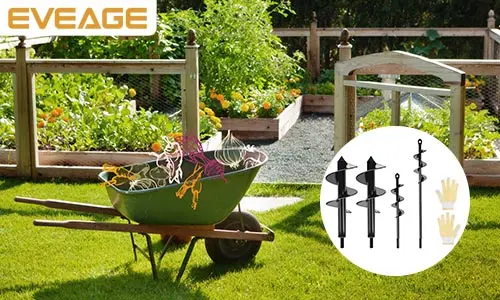Introduction
When it comes to planting bulbs and seeds, an auger bit is a must-have tool. An auger bit allows you to easily and efficiently dig up soil so you can plant your bulbs or seeds. However, not all auger bits are created equal! The right size of auger bit can make all the difference when it comes to productivity and overall efficiency of your work. In this article, we’re going to talk about what factors go into selecting the right size of auger for your specific needs.
There are a few factors you should keep in mind when it comes to selecting the right auger bit for your specific needs.
There are a few factors you should keep in mind when it comes to selecting the right auger bit for your specific needs.
-
Choose the correct material. The first thing to consider when choosing an auger bit is what kind of material it will be used on. For example, if you plan to drill holes into concrete or brick, you’ll need a solid carbide tip that can withstand repeated impacts with hard surfaces. On the other hand, if you plan on drilling through softer materials such as wood or soil—or even ice!—you may want something with less rigidity like tungsten carbide tips.
-
Choose the correct diameter of your auger bit. The average diameter for most common types of woodworking projects is ¼ inch; however, some people prefer using ⅛” instead because they feel it provides more control over their equipment while still being large enough not get stuck in their project at any point along its length (such as halfway through).
-
Choose a size based on how deep you want your hole dug before finishing up by hand with some digging spades or shovels which can take care of any remaining roots without damaging them too much since these tools were designed specifically for this purpose so there’s no need worry about damaging them either way–it’ll just save time overall compared having someone else do everything themselves!
Choose the correct material.
For example, you may need to choose between a steel auger and an aluminium auger. Both are strong materials, but for different reasons. Steel is very tough and durable, but it can rust if not properly cared for. Aluminium on the other hand is less resistant to corrosion than steel, but it’s lighter so that you won’t have as much weight in your hands while using it. Stainless steel is another option that combines the best elements of both: it’s strong like steel and won’t rust like aluminium!
Some people also prefer titanium because it has more resistance than stainless steel without being as heavy as titanium; others prefer iron because they think this material will last longer than others over time. If you’re looking for something stronger still though there’s always tungsten or carbide (which isn’t actually an element). Keep in mind though that these materials aren’t meant just for digging into soil; they’re used mostly by professionals who work with concrete all day long!
Your best bet would be ceramic or ceramic carbide–both these options will provide excellent durability even when exposed constantly under harsh conditions such as freezing winters where temperatures drop below freezing every night!”
Choose the correct diameter.
The diameter of the auger bit should be about the same size as the hole you are trying to drill. If you need to drill a larger hole, such as in soft ground or sandy soils, then a larger diameter auger bit is needed. If your soil is very hard and rocky, then a smaller diameter auger bit will be required.
The larger the auger bit, the slower it will go and more power will be needed to turn it. On soft ground or sandy soils where there are large rocks that may break off when drilling into them by hand (by hand) with an ordinary screwdriver-type handle;
However if you choose an electric-powered drill with variable speed control built into its housing then this problem can easily be overcome by just turning down its speed until it reaches maximum torque at which point it becomes perfectly safe for use on any surface without fear of damaging anything other than what one wants removed (in this case).
Choose the correct size auger.
If you’re thinking about planting bulbs, the first thing you’ll need to do is select the correct size auger. To do this, look at the bulb packages and see what size of hole they recommend for planting each variety. Then look for an auger that can fill in these holes with ease.
For instance, if you have a package of tulip bulbs that specifies three-inch deep holes and an auger capable of digging at least four inches deep (and preferably five), then your job will be much easier because it’s difficult for an amateur gardener to make such fine adjustments on their own without damaging precious plant roots or causing them harm by digging too shallowly into soil that could potentially cause problems later on down the road when growing season approaches again next year.
Selecting the best size auger can help improve productivity and overall efficiency of your work.
There are many different types of auger bits, each with its own unique features. Once you’ve selected the right type of bit, you need to determine its material and diameter. The material used in the construction of your auger will depend on several factors: how much pressure it will be subjected to, what kind of soil it is designed for (clearing snow or ice or digging into rock), and whether or not it needs to be able to withstand saltwater environments.
Some common materials include carbon steel (for working under high pressure), alloy steel (for use in shallow ground), hardened steel (for breaking through frozen earth), or titanium (if a lightweight version is needed). Once you’ve determined which type of material works best for your needs, there are still several factors left before selecting a particular model:
-
Diameter – This refers specifically to how wide an area around where the drill bit pierces through the ground; larger diameters allow faster drilling because they create more contact surface area between themselves and whatever they’re drilling into.* Length – The longer an auger’s shaft length is, the deeper penetration can go before needing another pass.* Pitch – This refers only when cutting through softer materials like clay since higher pitches mean greater torque while lower pitches offer less torque but provide greater stability when turning corners.* Number Of Teeth/Spurts – This refers only when cutting through harder materials like asphalt since higher numbers mean more teeth per inch which means faster grinding action while lower spurts mean slower grinding action
Conclusion
When it comes to selecting the right size auger bit for your specific needs, you will want to consider several factors. First, you need to choose the correct material. Next, consider choosing the correct diameter and size of auger. Finally, select an auger that is designed with your specific application in mind. As long as you keep these things in mind when shopping for an auger bit, then you will be able to find something that works perfectly for your job at hand!




